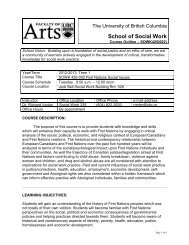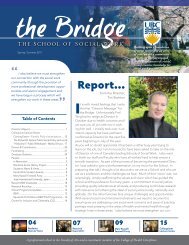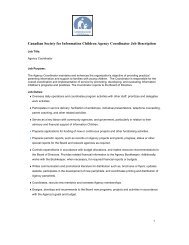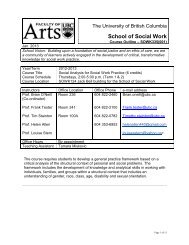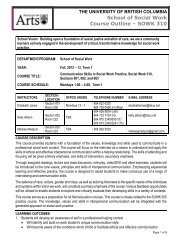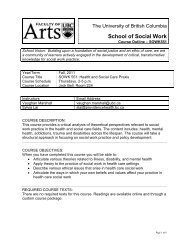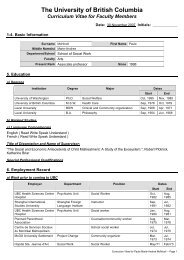Equity Case Studies Report - School of Social Work - University of ...
Equity Case Studies Report - School of Social Work - University of ...
Equity Case Studies Report - School of Social Work - University of ...
Create successful ePaper yourself
Turn your PDF publications into a flip-book with our unique Google optimized e-Paper software.
UBC school <strong>of</strong> social work equity and diversity strategic plan: A compilation <strong>of</strong> case studies 81<br />
Climate<br />
Despite the attempts <strong>of</strong> <strong>School</strong>s <strong>of</strong> <strong>Social</strong> <strong>Work</strong> to embrace equity and create ‘safe<br />
spaces’ for students to practice self-reflection and exploration, <strong>Social</strong> <strong>Work</strong> education is not<br />
separate from the institutions that they exist within, which are <strong>of</strong>ten “vehicles for containment<br />
and silencing” (Chan, 2005, p. 141). Academic sites, including <strong>School</strong>s <strong>of</strong> <strong>Social</strong> <strong>Work</strong>, are<br />
political sites. Examples <strong>of</strong> the challenges inherent in addressing climate and collegiality<br />
surfaced during many <strong>of</strong> the interviews for the individual case studies. Although there are<br />
challenges in addressing all aspects <strong>of</strong> equity and diversity within <strong>School</strong>s <strong>of</strong> <strong>Social</strong> <strong>Work</strong>, and<br />
educational sites as a whole, there is <strong>of</strong>ten an even greater disjuncture between policy and<br />
practice in addressing equity issues in classroom and school climate, and the difficulties to even<br />
put policies in place for ‘equitable climates’. Safe spaces and climate are difficult to measure.<br />
While numbers <strong>of</strong> self-identified minoritized and underrepresented students, faculty, and staff<br />
admitted and hired can be measured to examine equity in student admissions and faculty hiring,<br />
such an evaluation <strong>of</strong> ‘outcomes’ is not as easily obtained in terms <strong>of</strong> climate. Furthermore,<br />
climate is <strong>of</strong>ten intertwined with<br />
other elements <strong>of</strong> equity/inequity,<br />
such as the retention <strong>of</strong> students<br />
and faculty, curriculum, and<br />
Although there are challenges in addressing all aspects <strong>of</strong> equity<br />
and diversity within <strong>School</strong>s <strong>of</strong> <strong>Social</strong> <strong>Work</strong>, and educational<br />
sites as a whole, there is <strong>of</strong>ten an even greater disjuncture<br />
between policy and practice in addressing equity issues in<br />
classroom and school climate, and the difficulties to even put<br />
policies in place for ‘equitable climates’.<br />
pedagogy.<br />
Williams (2003) discusses pedagogical practices and strategies that can guide<br />
improvements in climate. She provides examples <strong>of</strong> common ‘best practices’, such as exposure<br />
to biographies, readings and presentations, and reflective writing assignments. She also notes the<br />
importance <strong>of</strong> dedicating additional attention to facilitated group learning, by spending time and



